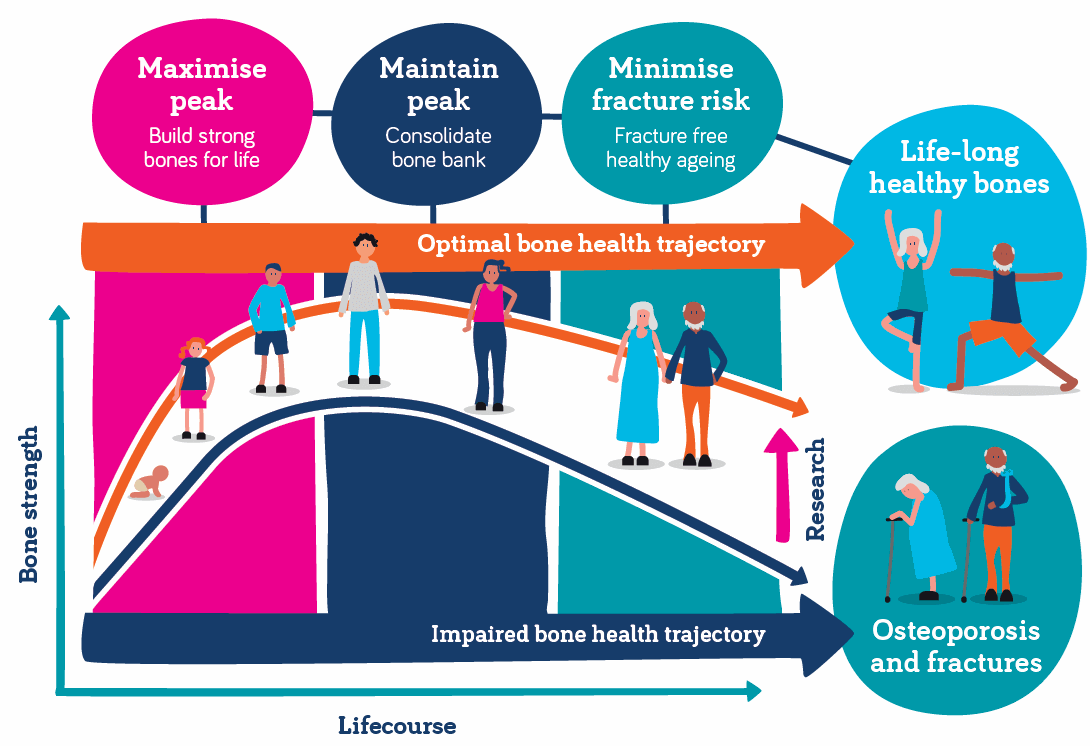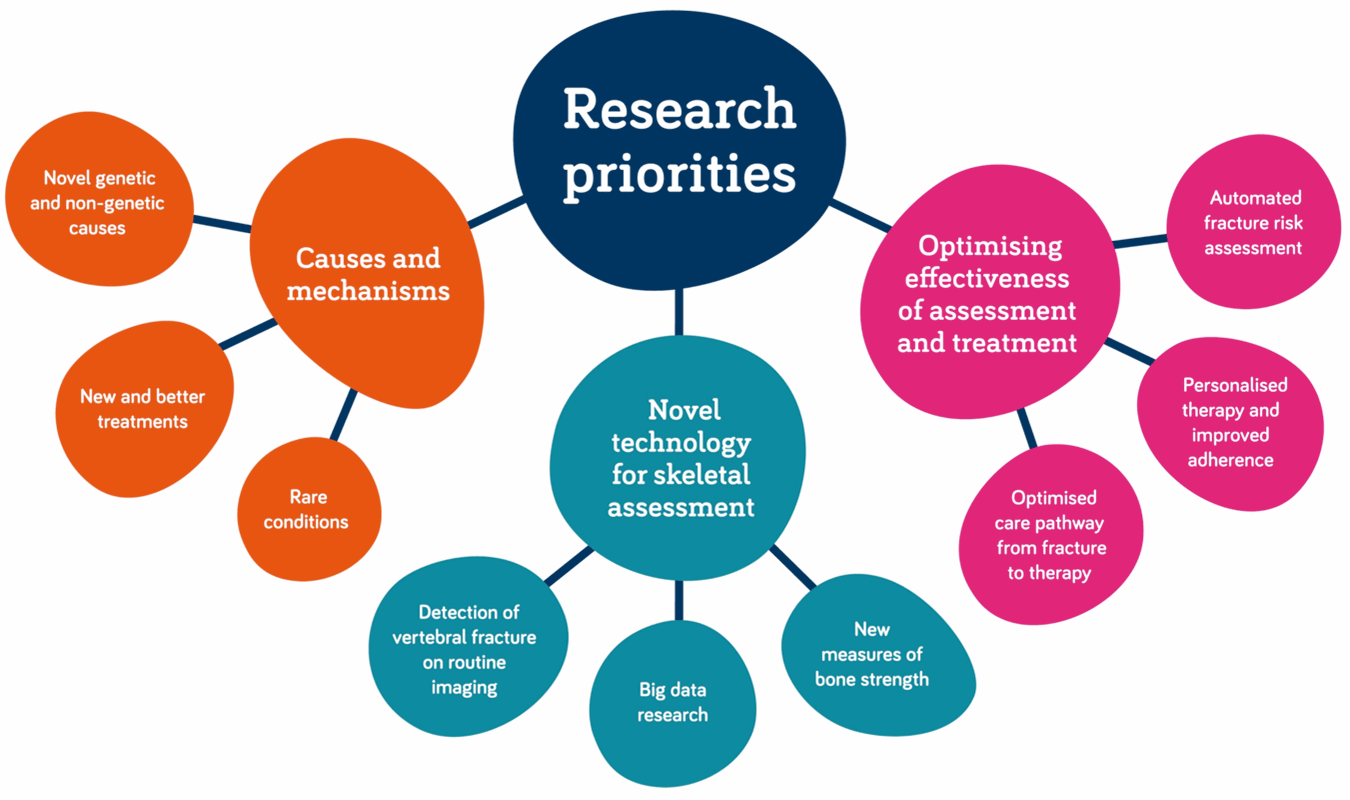Our Research Roadmap
Our Research Roadmap sets out the identified knowledge gaps in osteoporosis research and the key research priorities and will continue to guide our research investment decisions over the coming years. The Research Roadmap was developed by leading clinicians and academics, and those living with osteoporosis via the ROS Osteoporosis and Bone Research Academy.
The Research Roadmap was launched to experts in the field of osteoporosis and bone health in December 2020 at the digital learning event Osteoporosis Online and published in 2021.
Improving the bone health lifecourse through research
The Research Roadmap identified key gaps in research and clinical care across three phases of the lifecourse. The overarching aim is to ensure that bone development, growth and maintenance are optimised and bone loss and fracture risk are minimised (represented as the orange curve in the diagram below). This results in healthy bone ageing and ensures that all individuals avoid the impaired bone health trajectory that results in osteoporosis and fractures.

Three synergistic and closely interlinked research areas
Causes and Mechanisms
There are many factors that influence bone health and many routes to sub-optimal peak bone mass and osteoporosis. This journey starts as early as during development in the womb. The causes and mechanisms work stream will establish novel genetic and non-genetic causes, in particular:
- interrogating existing genome-wide association (genetic) data to develop new and better treatments;
- exploring mechanisms linking diet and the gut microbiome (the microorganisms in our bowel) to bone health;
- studying rare disorders, such as pregnancy and lactation associated osteoporosis, to understand mechanisms that may be applicable to osteoporosis more generally, and to improve the assessment and care of people suffering from these devastating conditions. Whilst there is already an impressive array of treatments for osteoporosis, greater understanding of underlying mechanisms will generate new and more effective preventive and therapeutic strategies, dramatically changing the outlook for patients.
Novel technology for skeletal assessment
New technologies are the particular focus here, bringing together cutting-edge advances:
- to facilitate opportunistic detection of vertebral fractures on routine hospital imaging;
- to use big data resources such as NHS clinical records and UK Biobank to identify novel risk factors;
- to derive new measures of bone strength, for example by applying machine learning algorithms to images obtained from diagnostic scans. Optimal use of state-of-the-art technology will lead to improved algorithms for risk assessment, enable the diagnosis of previously undetected spinal fractures and provide more accurate estimation of bone strength. Such advances will result in a step change in the ability to assess fracture risk and identify those who will benefit from osteoporosis treatments.
Optimising effectiveness of assessment and treatment
The effectiveness work stream will develop an integrated approach to the automated assessment of fracture risk, selection of appropriate therapy and optimisation of treatment adherence. This will provide:
- universal access to automatic fracture risk assessment in primary care;
- personalisation of therapy targeted to the individual level of fracture risk;
- achievement of an automated care pathway in people who fracture, including assessment, treatment and monitoring. The undertreatment of osteoporosis remains a key care gap, and successfully ensuring that every person at high fracture risk receives appropriate assessment and treatment for osteoporosis will result in a major advance in the care of these vulnerable patients.

ROS strategic focus for 2022-2026
In view of the scale and urgency of the osteoporosis care gap, for the duration of our Breaking the Silence Strategy 2022-2026, the charity will be focusing on the Technology and Effectiveness work streams of our Research Roadmap. However, after this strategy, in 2026, we’ll return to the other parts of our Research Roadmap, including the important causes and genetics agenda.
Research Roadmap supporting publications
The Research Roadmap is supported by several open-access key position papers which were generated by the Osteoporosis and Bone Research Academy (2019-2022) to set out the blueprint for innovative research studies in the coming years.
Towards a cure for osteoporosis: the UK Royal Osteoporosis Society (ROS) Osteoporosis Research Roadmap
Harvey, N.C., Poole, K.E., Ralston, S.H, McCloskey E.V, Sangan C.B, Wiggins L, Jones C, Gittoes N, Compston J and ROS Osteoporosis and Bone Research Academy (2022). Towards a cure for osteoporosis: the UK Royal Osteoporosis Society (ROS) Osteoporosis Research Roadmap. Arch Osteoporos.17 (1): 12. (full paper available here).
Opportunities and challenges in functional genomics research in osteoporosis
Tobias JH, Duncan EL, Kague E, Hammond CL, Gregson CL, Bassett D, Williams GR, Min JL, Gaunt TR, Karasik D, Ohlsson C, Rivadeneira F, Edwards JR, Hannan FM, Kemp JP, Gilbert SJ, Alonso N, Hassan N, Compston JE, Ralston SH. Opportunities and challenges in functional genomics research in osteoporosis: report from a workshop Held by the Causes Working Group of the Osteoporosis and Bone Research Academy of the Royal Osteoporosis Society on October 5th 2020. (2021). Front Endocrinol (Lausanne). Feb 15;11:630875. (full paper available here).
Opportunistic diagnosis of osteoporosis, fragile bone health and vertebral fractures from routine CT scans; a review of approved technology systems and pathways to implementation
Aggarwal V, Maslen C, Abel RL, Bhattacharya P, Bromiley PA, Clark EM, Compston JE, Crabtree N, Gregory JS, Kariki EP, Harvey NC, Ward KA, Poole KES. On behalf of the Technology Working Group of the Osteoporosis and Bone Research Academy, Royal Osteoporosis Society. Opportunistic diagnosis of osteoporosis, fragile bone health and vertebral fractures from routine CT scans; a review of approved technology systems and pathways to Implementation. (2021). Ther Adv Musculoskel Dis. 13: 1–19. (full paper available here).
Role of the intestinal microbiome in regulating bone metabolism and susceptibility to osteoporosis
Cronin O, Lanham-New S, Thompson B, Thompson F, Corfe BM, Gregson C, Darling A, Ahmadi K, Gibson PS, Gibson G, Tobias JH, Ward K, Traka M, Rossi M, Williams C, Harvey N, Cooper C, Whelan K, Uitterlinden AG, O’Toole PW, Ohlsson C, Compston JE, Ralston SH. Role of the intestinal microbiome in regulating bone metabolism and susceptibility to osteoporosis: Report from a workshop held by the Causes Working Group of the Osteoporosis and Bone Research Academy of the Royal Osteoporosis Society. (2022). Calcified Tissue International. 110:273–284. (full paper available here).
Digital health interventions for osteoporosis and post-fragility fracture care
Gupta A, Maslen C, Vindlacheruvu M, Abel RL, Bhattacharya P, Bromiley PA, Clark EM, Compston JE, Crabtree N, Gregory JS, Kariki EP, Harvey NC, McCloskey E, Ward KA, Poole KES. On behalf of the Technology Working Group of the Osteoporosis and Bone Research Academy, Royal Osteoporosis Society. Digital health interventions for osteoporosis and post-fragility fracture Care. (2022). Ther Adv Musculoskel Dis. 14: 1–12. (full paper available here).
Supporting patients to get the best from their osteoporosis treatment; what works for whom, why and in what circumstance: a rapid realist review
Paskins Z, Babatunde O, Sturrock A, Shean Toh L, Horne R, Maidment I, on behalf of the Effectiveness Working Group of the Royal Osteoporosis Society Osteoporosis and Bone Research Academy. Supporting patients to get the best from their osteoporosis treatment; what works for whom, why and in what circumstance: a rapid realist review. (2022). Osteoporos Int. 33(11)2245-2257. (full paper available here).
Development of the Research Roadmap
Find out more about the Osteoporosis and Bone Research Academy and the members of the Advisory Committee, Working Groups and Patient Advocates who supported the development of the Research Roadmap.
The importance of the patient perspective
Patient advocates sat on all the Osteoporosis and Bone Research Academy Committee and Working Groups as equal partners and were fully involved in setting the research priorities. A critical element in the development of the Research Roadmap was also the contribution of wider patient insight, to ensure that patients’ priorities and expectations were comprehensively represented and incorporated. Patients’ views on the proposed research topics were received from 2,000 ROS members. All the research priorities were rated as either ‘extremely’ or ‘very’ important by at least 80% of respondents.

Please note that our Research Roadmap was published prior to the 2022 announcement that the Osteoporosis and Bone Research Academy would be concluded in its original, research-focused form, and repurposed to become a home for our professional education and leadership cultivation products (The Osteoporosis and Bone Health Academy). Find out more here.
For more information:
-
E-mail research@theros.org.uk or call us on 01761 473125
 Search
Search
 Login
Login


